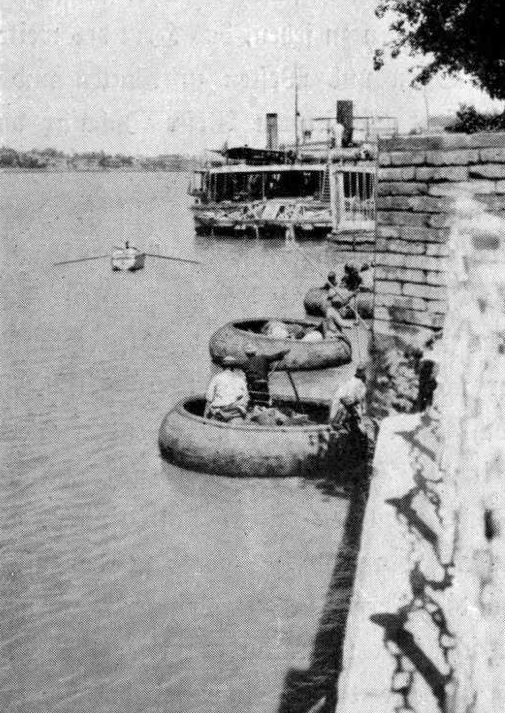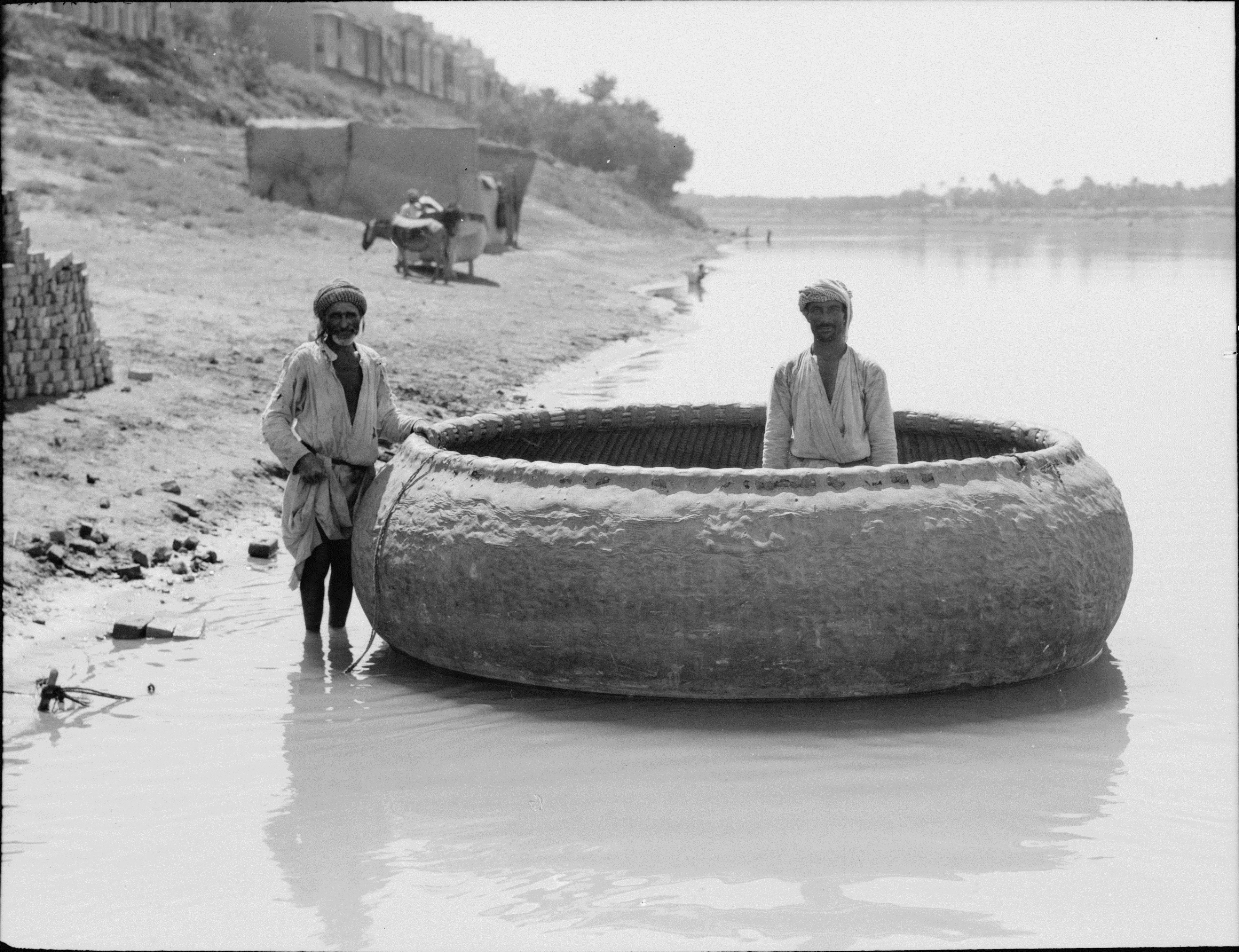|
Quffa
A kuphar (also transliterated kufa, kuffah, quffa, quffah, etc.) is a type of coracle or round boat traditionally used on the Tigris and Euphrates rivers in ancient and modern Mesopotamia. Its circular shape means that it does not sail well against the current, as it tends to spin, but makes it safe, sturdy and easy to construct. A kuphar is propelled by paddling, rowing or poling. Etymology The word "kuphar" is derived from the Arabic word (), meaning a basket woven from reeds and leaves. The boat visually resembles a basket and is used for a similar purpose: transporting fruits, vegetables, and other goods. The Arabic word in turn originated from the Akkadian word , meaning basket. History Reliefs depicting kuphars have been found in Assyrian ruins dating to the reigns of Kings Ashurnasirpal II (883 to 859 BC), Sennacherib (705 to 681 BC), and Ashurbanipal (668 to 627 BC), who reigned during the 9th, 8th, and 7th centuries BC, respectively. A translation of a tablet ... [...More Info...] [...Related Items...] OR: [Wikipedia] [Google] [Baidu] |
Coracle
A coracle is a small, rounded, lightweight boat of the sort traditionally used in Wales, and also in parts of the West Country and in Ireland, particularly the River Boyne, and in Scotland, particularly the River Spey. The word is also used of similar boats found in India, Vietnam, Iraq, and Tibet. The word ''coracle'' is an English spelling of the original Welsh , cognate with Irish and Scottish Gaelic , and is recorded in English text as early as the sixteenth century. Other historical English spellings include ''corougle'', ''corracle'', ''curricle'' and ''coricle''. Structure The structure is made of a framework of split and interwoven willow rods, tied with willow bark. The outer layer was originally an animal skin such as horse or bullock hide (corium), with a thin layer of tar to waterproof it – today replaced by tarred calico, canvas, or fibreglass. The Vietnamese/Asian version of the coracle is made of interwoven bamboo and made water proof by using resin and coconu ... [...More Info...] [...Related Items...] OR: [Wikipedia] [Google] [Baidu] |
Kuphar
A kuphar (also transliterated kufa, kuffah, quffa, quffah, etc.) is a type of coracle or round boat traditionally used on the Tigris and Euphrates rivers in ancient and modern Mesopotamia. Its circular shape means that it does not sail well against the current, as it tends to spin, but makes it safe, sturdy and easy to construct. A kuphar is propelled by paddling, rowing or setting pole, poling. Etymology The word "kuphar" is derived from the Arabic word (), meaning a basket woven from reeds and leaves. The boat visually resembles a basket and is used for a similar purpose: transporting fruits, vegetables, and other goods. The Arabic word in turn originated from the Akkadian language, Akkadian word , meaning basket. History Reliefs depicting kuphars have been found in Assyrian ruins dating to the reigns of Kings Ashurnasirpal II (883 to 859 BC), Sennacherib (705 to 681 BC), and Ashurbanipal (668 to 627 BC), who reigned during the 9th, 8th, and 7th centuries BC, respectively. A tr ... [...More Info...] [...Related Items...] OR: [Wikipedia] [Google] [Baidu] |
James Hornell
James Hornell (1865 – February 1949) was an English zoologist and seafaring ethnographer. He was a cousin of Edward Atkinson Hornel, a Scottish painter. Career As a zoologist Hornell published a number of papers on marine organisms working most notably with his father in law Joseph Sinel in Jersey, and in 1900 traveled to Ceylon (now Sri Lanka) to report on the pearl fisheries. Staying there for six years, Hornell published a number of papers on the pearling industry. While there he was elected a Fellow of the Linnean Society for his work on marine worms. After working for several more years in India, organizing the fisheries of Madras, he retired, and thus began his next career as an ethnographer of seafarming and maritime life. He traveled extensively around the Indian Ocean world and east Asia, making records of indigenous watercraft, sailing on Junks and Sampans, and as a member of an expedition to the south seas made many records of the watercraft of Polynesia. Further ... [...More Info...] [...Related Items...] OR: [Wikipedia] [Google] [Baidu] |
Bitumen
Asphalt, also known as bitumen (, ), is a sticky, black, highly viscous liquid or semi-solid form of petroleum. It may be found in natural deposits or may be a refined product, and is classed as a pitch. Before the 20th century, the term asphaltum was also used. Full text at Internet Archive (archive.org) The word is derived from the Ancient Greek ἄσφαλτος ''ásphaltos''. The largest natural deposit of asphalt in the world, estimated to contain 10 million tons, is the Pitch Lake located in La Brea in southwest Trinidad (Antilles island located on the northeastern coast of Venezuela), within the Siparia Regional Corporation. The primary use (70%) of asphalt is in road construction, where it is used as the glue or binder mixed with aggregate particles to create asphalt concrete. Its other main uses are for bituminous waterproofing products, including production of roofing felt and for sealing flat roofs. In material sciences and engineering, the terms "asphalt" an ... [...More Info...] [...Related Items...] OR: [Wikipedia] [Google] [Baidu] |
Basketry
Basket weaving (also basketry or basket making) is the process of weaving or sewing pliable materials into three-dimensional artifacts, such as baskets, mats, mesh bags or even furniture. Craftspeople and artists specialized in making baskets may be known as basket makers and basket weavers. Basket weaving is also a rural craft. Basketry is made from a variety of fibrous or pliable materials—anything that will bend and form a shape. Examples include pine, straw, willow, oak, wisteria, forsythia, vines, stems, animal hair, hide, grasses, thread, and fine wooden splints. There are many applications for basketry, from simple mats to hot air balloon gondolas. Many Indigenous peoples are renowned for their basket-weaving techniques. History While basket weaving is one of the widest spread crafts in the history of any human civilization, it is hard to say just how old the craft is, because natural materials like wood, grass, and animal remains decay naturally and constantly. So ... [...More Info...] [...Related Items...] OR: [Wikipedia] [Google] [Baidu] |
Reed (plant)
Reed is a common name for several tall, grass-like plants of wetlands. Varieties They are all members of the order Poales (in the modern, expanded circumscription), and include: In the grass family, Poaceae * Common reed (''Phragmites australis''), the original species named reed * Giant reed (''Arundo donax''), used for making reeds for musical instruments * Burma reed (''Neyraudia reynaudiana'') * Reed canary-grass (''Phalaris arundinacea'') * Reed sweet-grass (''Glyceria maxima'') * Small-reed (''Calamagrostis'' species) In the sedge family, Cyperaceae * Paper reed or papyrus ('' Cyperus papyrus''), the source of the Ancient Egyptian writing material, also used for making boats In the family Typhaceae * Bur-reed (''Sparganium'' species) * Reed-mace (''Typha'' species), also called bulrush or cattail In the family Restionaceae * Cape thatching reed ('' Elegia tectorum''), a restio originating from the South-western Cape, South Africa. * Thatching reed (''Thamnochortus ins ... [...More Info...] [...Related Items...] OR: [Wikipedia] [Google] [Baidu] |
Tonne
The tonne ( or ; symbol: t) is a unit of mass equal to 1000 kilograms. It is a non-SI unit accepted for use with SI. It is also referred to as a metric ton to distinguish it from the non-metric units of the short ton ( United States customary units), and the long ton ( British imperial units). It is equivalent to approximately 2204.6 pounds, 1.102 short tons, and 0.984 long tons. The official SI unit is the megagram (symbol: Mg), a less common way to express the same mass. Symbol and abbreviations The BIPM symbol for the tonne is t, adopted at the same time as the unit in 1879.Table 6 . BIPM. Retrieved on 2011-07-10. Its use is also official for the metric ton in the United States, having been adopted by the United States |
Donkey
The domestic donkey is a hoofed mammal in the family Equidae, the same family as the horse. It derives from the African wild ass, ''Equus africanus'', and may be classified either as a subspecies thereof, ''Equus africanus asinus'', or as a separate species, ''Equus asinus''. It was domesticated in Africa some years ago, and has been used mainly as a working animal since that time. There are more than 40 million donkeys in the world, mostly in underdeveloped countries, where they are used principally as draught or pack animals. While working donkeys are often associated with those living at or below subsistence, small numbers of donkeys or asses are kept for breeding or as pets in developed countries. A male donkey is known as a ''jack'' or ''jackass'', a female is a ''jenny'' or ''jennet'', and an immature donkey of either sex is a '' foal''. Jacks are often mated with female horses (mares) to produce '' mules''; the less common hybrid of a male horse (stallion) and j ... [...More Info...] [...Related Items...] OR: [Wikipedia] [Google] [Baidu] |
Talent (measurement)
The talent was a unit of weight that was introduced in Mesopotamia at the end of the 4th millennium BC, and was normalized at the end of the 3rd millennium during the Akkadian-Sumer phase, divided into 60 minas or 3,600 shekels. In classical antiquity, the talent ( la, talentum, from Ancient Greek: , ''talanton'' "scale, balance, sum") was the heaviest of common weight units for commercial transactions. An Attic weight talent was approximately John William Humphrey, John Peter Oleson, Andrew Neil Sherwood, ''Greek and Roman technology'', p. 487. (approximately the mass of water of an amphora), and a Babylonian talent was .Herodotus, Robin Waterfield and Carolyn Dewald, ''The Histories'' (1998), p. 593. Ancient Israel adopted the Babylonian weight talent, but later revised it.III. Measures of W ... [...More Info...] [...Related Items...] OR: [Wikipedia] [Google] [Baidu] |
Palm-tree
The Arecaceae is a family of perennial flowering plants in the monocot order Arecales. Their growth form can be climbers, shrubs, tree-like and stemless plants, all commonly known as palms. Those having a tree-like form are called palm trees. Currently, 181 genera with around 2,600 species are known, most of which are restricted to tropical and subtropical climates. Most palms are distinguished by their large, compound, evergreen leaves, known as fronds, arranged at the top of an unbranched stem. However, palms exhibit an enormous diversity in physical characteristics and inhabit nearly every type of habitat within their range, from rainforests to deserts. Palms are among the best known and most extensively cultivated plant families. They have been important to humans throughout much of history. Many common products and foods are derived from palms. In contemporary times, palms are also widely used in landscaping. In many historical cultures, because of their importance ... [...More Info...] [...Related Items...] OR: [Wikipedia] [Google] [Baidu] |
Willow
Willows, also called sallows and osiers, from the genus ''Salix'', comprise around 400 speciesMabberley, D.J. 1997. The Plant Book, Cambridge University Press #2: Cambridge. of typically deciduous trees and shrubs, found primarily on moist soils in cold and temperate regions. Most species are known as willow, but some narrow-leaved shrub species are called osier, and some broader-leaved species are referred to as sallow (from Old English ''sealh'', related to the Latin word ''salix'', willow). Some willows (particularly arctic and alpine species) are low-growing or creeping shrubs; for example, the dwarf willow (''Salix herbacea'') rarely exceeds in height, though it spreads widely across the ground. Description Willows all have abundant watery bark sap, which is heavily charged with salicylic acid, soft, usually pliant, tough wood, slender branches, and large, fibrous, often stoloniferous roots. The roots are remarkable for their toughness, size, and tenacity to live ... [...More Info...] [...Related Items...] OR: [Wikipedia] [Google] [Baidu] |







